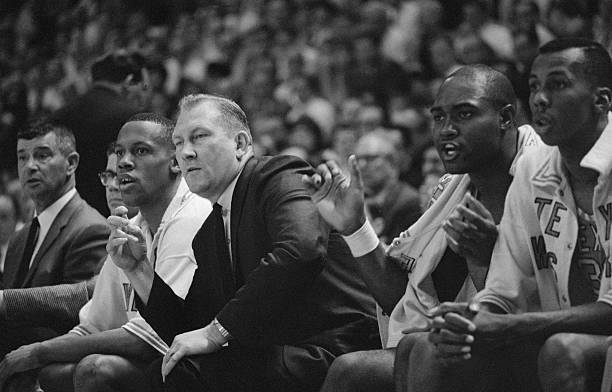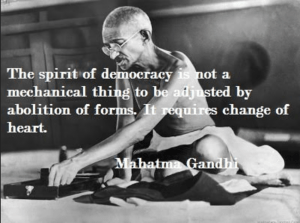The Kansas Jayhawks threw in the ball as the clock was winding down. Three, two, one, the Jayhawk, Jojo White, took his shot and sank a buzzer-beating shot. The crowd roared “Kansas wins, Kansas wins, Kansas wins!” Then whistles started to blow, and the basket was called off because Jojo White’s heel had gone out of bounds before his shot. The Texas Western Miners won 81-80. History is about highlighting the most critical moments in time, but this event is often overlooked or untold when discussing Don Haskins and his 1966 Miners. If this one incident had not happened, I would not be here today talking about how Don Haskins led the first all-black starting line up in NCAA history to win the NCAA Championship.1

In 1961, when Coach Haskins went to interview for the coaching position at Texas Western, he was coaching Girls Basketball in a little town called Dumas, Texas, where he had just had three of his girls commit to play division 1 basketball.2 When Haskins got to the interview, he basically got the job on the spot, but he could only work there if he would live in the dorms and get the kids living at the dorms under control. Aside from having to live in the dorms with his family, Haskins would only making $600 from the booster club to work there.3
Nonetheless, Haskins was determined to compete with the best, no matter the conditions. Texas Western gave him the opportunity to do so on a division 1 basketball team. Haskins did not just want to go through the motions. He was determined to make this team successful and outdo the mediocre goals that the college had held for his team; so he began to recruit and seek out talent. The first player he acquired was Bobby Joe Hill. However, Bobby Joe Hill was an African-American player, and the school had an issue with that. Haskins refused to let the school affect who he was recruiting though, and said: “I don’t see Black and White, I see players.”4 This statement was reflected in his recruiting; Haskins saw talent and understood that it came in all shapes and sizes. After his first season, his team finished 18-6, which was unheard of from the Miners in those years.5
This positive development of the Miners would continue, and Haskins continued to seek out the best talent he could acquire aggressively. In the season of 1964, Haskins picked up eight: David “Big Daddy D” Latin, Willie Worsley, Willie Cager, Nevil Shed, Harry Flournoy, Ornstein Artis, and… Bobby Joe Hill. These eight African-American men were about to make history with coach Haskins and change the game of basketball forever. However, these newly acquired athletes meant Haskins would start five black players consistently, and this fact bothered a lot of people. Haskins received death threats in the mail, telling him to stop starting black players, but Haskins insisted that he didn’t play color, that he played talent and heart, and that people would know it if he did not have his best five players on the court.6
1966 Miners | Courtesy of YouTube
The 1966 season came around, and the Miners had just come off a season where they made it to the NIT tournament, which is better than they had done in any other year. Haskins knew his team was destined for greatness, so he continued to push them to their limits and get them to work as a team. Haskins believed in this team when nobody else did. They started the 1964-1965 season unranked and not on anyone’s radar. The first eight games were 8-0, and all the momentum seemed to be rolling in the Texas Western’s favor. The highlight of the season was definitely when the Miners beat the fourth best team in the nation, Iowa. This victory was a wake-up call to the country, showing everyone that they meant business. Through these eight games, the miners had only one close match, which was against Fresno State, but they rebounded hard, winning by 18 the next day in an absolute beatdown against Latoya.7
As this team began to have success and gain national notoriety, death threats began surfacing as well, and it became harder to find hotels that would allow the team to stay in them. However, Haskins was not shaken. He was determined to let his boys play, and he was not going to let others dictate how he was coaching his team. There was even one incident where one of his players got jumped in the bathroom and beaten up. After the incident, Hawkins made the team go places in groups to try to prevent things like that from ever happening again.8

The Miners remained undefeated until their last game of the season, where they lost to the unranked Seattle. The night before this game, Bobby Joe Hill decided to get the team to sneak out and go meet up with some friends and party. Haskins was very disappointed with the team. They had all gone missing,then played lazily, and had overlooked the Seattle team because they had already clinched a spot in the tournament. He was disappointed, but was more concerned about the coming NCAA tournament. When the tournament came around, Haskins became very hard on the boys. He didn’t want them to blow the opportunity they had earned. Bobby Joe Hill was benched in the first game because Haskins wanted to make a statement to the team. Hill was not only the leader of the party debacle, but also the captain of the team; so this would give the team their first chance to show others what they could do without their starting point guard Bobby Joe. Haskins said that Hill took his punishment well and served as the hype man trying to keep the team’s spirits up. Although Hill was benched, it turned out the Miners needed Hill a lot more than Haskins thought; so he put Hill in when the Miners were down by seventeen. The boys fought back once Hill was in, and won 89-74 against Oklahoma City.9
The regional finals came around and the Miners barely got by in an 81-80 overtime victory over the Kansas Jayhawks. The day after that win, Haskins gave the team the day off, and then the next morning they met for practice. Reporters and people were gathered to watch the Miners practice. Coach Haskins noticed Bobby Joe Hill was joking around at practice, and he yelled at Hill saying “I hope you get your ass kicked, I am sick and tired of your crap!”10 And he then proceeded to throw him out of practice. When Haskins was leaving practice, a coach stopped him and asked: “Don, how do you talk to your Black players that way?” and Haskins turned around and said, “The same way I talk to my White Ones.”11 Utah was an easy win for the Miners, as they won 85-79 and advanced to play Kentucky in the National Championship.
Haskins understood that the Kentucky team was significantly bigger than the Miners, so he wanted to start a squad with three guards, so that they would have a speed advantage on them. His starting line up consisted of Bobby Joe Hill, David Lattin, Willie Worsley, Willie Cager, and Orsten Artis. It was later released that the Kentucky Coach had openly said to Sports Illustrated that he did not want to lose to a bunch of “coons.”12 That statement made this game so much more than just the championship; the game that Haskins and his boys were playing for was for a change in our country. It is was the first time in NCAA history that a line up had had five black starters, and at tip-off, Haskins made sure to tell David Lattin to make a statement with the first basket.

So Lattin did just that, he dunked on hall of famer Pat Reily and held on to the rim while looking down on him. Right out the gates, the Miners meant business. During the game, the Miners were up 10-9 with 10.09 left in the 1st, and Bobby Joe Hill stole the ball and made two throw-ins in a row, which put them up to 14-9. These Miners meant business and weren’t going to back down. Haskins had finally got his chance to play with the “Big Boys,” and the Miners looked solid. They went on to win the National Championship in a fairly easy victory, ending the game 72-65. To this day, it is known as one of the greatest upsets in sports history.13
These boys made history and also made a huge statement for the civil rights movement at a vital time in 1966, but none of this could have been done without their coach, Don Haskins. This man recruited a team that came from so many backgrounds, whether it be Houston, the Bronx, or Amarillo, and he saw these boys as good ball players and not as black or white. He made almost nothing coaching these boys, and not only won a national championship, but turned these boys into men.

His legacy lives on today in El Paso, Texas where they named the basketball arena at UTEP (formerly known as Texas Western) after him. El Paso has yet to see a coach or team as great as Haskins’ or the 1966 Miners. Coach Haskins was inducted into the hall of fame in 1997, and his entire 1966 team was inducted into the NCAA Basketball Hall of Fame in 2007. Coach Haskins died on September 9, 2008, and left a stamp on his players, family, friends, El Paso, and his country. 14 His story truly is amazing, and what his Mighty Miners accomplished is undoubtedly one for the books.
- Jaime Schultz, “Glory Road (2006) and the White Savior Historical Sports Film,” Journal Of Popular Film & Television 42, no. 4 (October 2014): 212-213. ↵
- Britannica Encyclopedia, September 2008, s.v. “Don Haskins,” by Karen Sparks. ↵
- Coach Don Haskins with Wetzel, Glory Road: My Story of the 1966 NCAA Basketball Championship and How One Team Triumphed Against the Odds and Changed America Forever (New York: Hachette, 2016), 64. ↵
- Coach Don Haskins with Wetzel, Glory Road: My Story of the 1966 NCAA Basketball Championship and How One Team Triumphed Against the Odds and Changed America Forever (New York: Hachette, 2016), 79. ↵
- Coach Don Haskins with Wetzel, Glory Road: My Story of the 1966 NCAA Basketball Championship and How One Team Triumphed Against the odds and Changed America Forever (New York: Hachette, 2016), 79. ↵
- Jaime Schultz, “Glory Road (2006) and the White Savior Historical Sport Film,” Journal Of Popular Film & Television 42, no. 4 (October 2014): 205-207. ↵
- Jaime Schultz, “Glory Road (2006) and the White Savior Historical Sports Film,” Journal Of Popular Film & Television 42, no. 4 (October 2014): 207. ↵
- Jaime Schultz, “Glory Road (2006) and the White Savior Historical Sport Film,” Journal Of Popular Film & Television 42, no. 4 (October 2014): 214-215. ↵
- Coach Don Haskins with Wetzel, Glory Road: My Story of the 1966 NCAA Basketball Championship and How One Team Triumphed Against the odds and Changed America Forever (New York: Hachette, 2016), 159. ↵
- Coach Don Haskins with Wetzel, Glory Road: My Story of the 1966 NCAA Basketball Championship and How One Team Triumphed Against the odds and Changed America Forever (New York: Hachette, 2016), 176. ↵
- Coach Don Haskins with Wetzel, Glory Road: My Story of the 1966 NCAA Basketball Championship and How One Team Triumphed Against the odds and Changed America Forever (New York: Hachette, 2016), 177. ↵
- Sean Patrick Adams, “Warming the Poor and Growing Consumers: Fuel Philanthropy in the Early Republic’s Urban North,” Journal of American History 95, no. 1 (June 2008): 76-77. ↵
- Bryan E. Denham, Sport Media and Mega Events (New York: Routledge, 2017), 76. ↵
- Encyclopedia Britannica, September 2008, s.v. “Don Haskins,” by Karen Sparks. ↵



43 comments
Christopher Vasquez
This is a great article! It’s well written and suspenseful. I didn’t know the history behind this team, and it seems like they paved the way for the future generations. Don Haskin was a man of the future, knowing what others refused to acknowledge: that race doesn’t matter. His responses to the reporters were revealing of his character. He truly only wanted what was best for his team, and he did what he could to push them harder. I was disappointed that Bobby Joe Hill, the team’s captain, convinced the team to go out and party the night before a big game; however, I was impressed that the coach handled it well. He did not seem to yell or become furious. Instead, he was just disappointed in such a poor decision. Despite that, Hill was still respectful of his coach and a great role model for the rest of his team. The opening part of this article was amazing! Good Job!
Robert Freise
The story of the only collegiate basketball team in Texas to win a NCAA championship is very interesting. The integration of African American men in the the game revolutionized the culture of basketball. The team was not just a team but a it was a civil right movement as well. The constent media pressure thatb people put on Haskins was very hard and the players used that motivation on the court and won the 1966 collegiate championship.
Avery Looney
This article is very well written and researched. Everyone loves a great underdog story, and that’s exactly what the Miners were. Nobody in that day had seen an all black line up, and the Miners not only battled their opponent on the court, but also racism. This team played a huge part in the civil rights movement and proved to the nation that your background or the color of your skin does not matter. This team defied all the odds and made history.
Nathan Hartley
I love reading about the underdog, especially in basketball. I thought it was interesting that the coach decided to bench the starting point guard, but I can see why he did it. Sending a message that the coach was serious was a smart move, and I believe that is what helped them upset the Kentucky team. It is also satisfying to read that the Kentucky coach lost that game after being racist.
Miguel Rivera
Often times a team mimics the attitude and ferocity of their coach, and that’s exactly what the Miners did those years. A basketball team is much smaller in numbers than other sports so you get to know your teammates very well, and your coach knows each and every single player on a personal level. So to read about how this small school won the NCAA tournament, with the adversity they faced to get to that position should be known to everybody especially the current UTEP students.
Adrian Cook
Racism was dominant in sports because Anglo Americans didn’t want African Americans to play sports that were consisted of whites. The Mighty Miners were another example of fighting for equality no matter what backlash you’ll take. Everybody should be able to play sports if you have the skill and not judged by the color of your skin. I’m happy coach Haskins stood up for what he believed was right because it changed sports today.
Donte Joseph
Basketball was not always as integrative as it is today but steps like the ones Don Haskins took are what makes baseball so enjoyable today. Despite high racial tensions, Haskins refused to give into the pressure of others and played five African Americans with pride. Being the underdogs, Haskins decision to play five African Americans was the start to changing basketball to what it is now.
Caden Floyd
It’s crazy to think that a game can make such a bis statement in such an important time. The Mighty Miners might not have realized it at the time, but they were about to make a huge push for African American basketball players and the community as a whole. Despite the death threats and hate letters Don Haskins and his supporting wife did what they knew was right and that all that matters. It gave me chills reading about David Lattin dunking on hall of famer Pat Reily and staring down at him as he hung onto the rim. I’ve seen the movie Glory Road, but this article really explains what the players and Coach Haskins went through during this hard tome and how they overcame all odds.
Lorenzo Rivera
This story is truly amazing. Don Haskins forever changed the game of basketball with one championship season at Texas Western University, know known as The University of Texas at El Paso. Being from El Paso, I have heard of this story my entire life, and it always seems to make me happy. This underdog story proved to the entire world exactly what is possible if we are willing to accept change. This story is extremely inspiring, and one that will be told for generations.
Maxx Arizmendi
I love basketball, and this article helped me understand how Coach Haskins changed the game of basketball forever. I admire the fact that he was so brave in starting five African-American players against an all-white Kentucky team. Despite receiving death threats and all that, Haskins didn’t really care what the fans were thinking; he just wanted to win. What makes the story even more interesting is the fact that this was during the civil rights movement, when America is racially divided. Coach Haskins is probably considered to be an a civil rights advocate for what he did, and that’s what I admire.